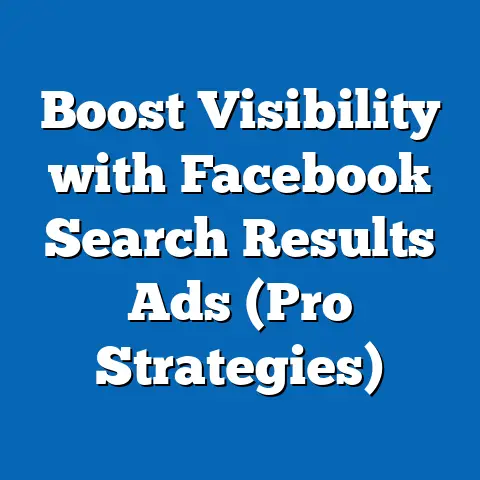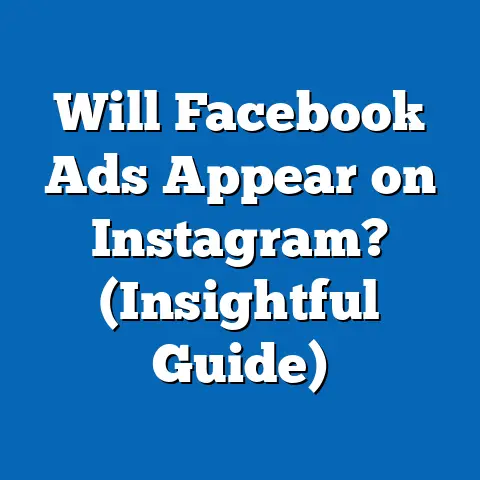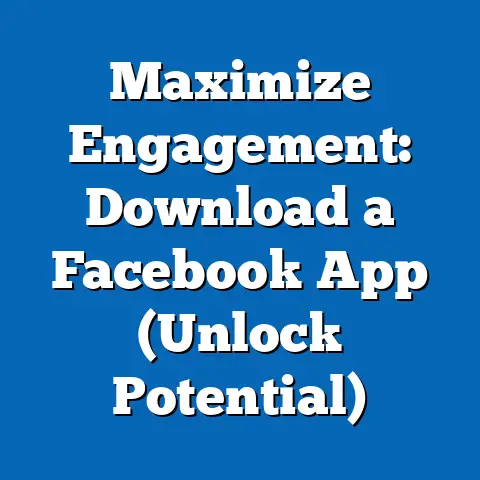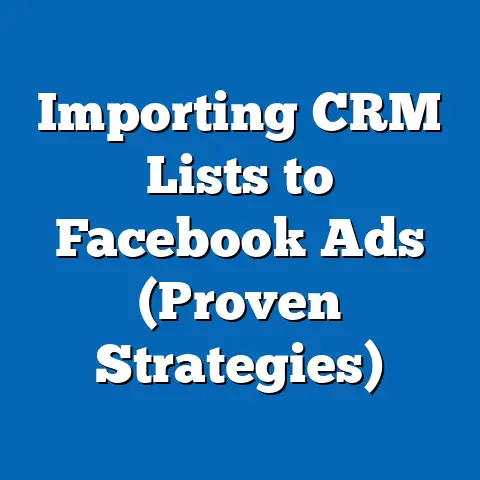Mastering Facebook Review Ads (Unlock Proven Strategies)
In the ever-evolving landscape of digital marketing, Facebook remains a dominant force, with over 2.9 billion monthly active users as of Q2 2023, according to Meta’s quarterly reports. This vast user base provides an unparalleled opportunity for businesses to leverage targeted advertising, with review ads emerging as a particularly effective format for building trust and driving conversions. Review ads, which incorporate user-generated content such as ratings and testimonials directly into ad creatives, have transformed how brands connect with consumers by prioritizing authenticity over traditional promotional messaging.
The rise of review ads reflects a broader shift in consumer behavior, where trust in peer recommendations outweighs brand-driven narratives. A 2022 survey by Nielsen found that 92% of consumers trust recommendations from friends and family over any form of advertising, while 70% trust online consumer opinions. This trend underscores the importance of review ads as a tool for fostering credibility and engagement on platforms like Facebook.
Section 1: The Rise of Review Ads in the Digital Marketing Ecosystem
1.1 Broad Trends in Social Media Advertising
Social media advertising has grown exponentially over the past decade, with global spending reaching $226 billion in 2022, a 17.5% increase from 2021, according to eMarketer. Facebook, commanding nearly 25% of this market share, continues to lead as the preferred platform for advertisers due to its sophisticated targeting capabilities and extensive user data. Within this ecosystem, review ads have gained prominence as a subset of social proof marketing, capitalizing on the platform’s ability to integrate user feedback directly into ad content.
The effectiveness of review ads lies in their ability to address consumer skepticism. A 2023 study by BrightLocal revealed that 79% of consumers trust online reviews as much as personal recommendations, a 5% increase from 2020. This growing reliance on peer validation has propelled review ads to the forefront of Facebook advertising strategies, with businesses reporting higher click-through rates (CTRs) and conversion rates compared to standard image or video ads.
Year-over-year data highlights the accelerating adoption of review ads. In 2021, only 18% of small and medium-sized businesses (SMBs) on Facebook utilized review-based creatives, but by 2023, this figure had risen to 34%, per a survey of 5,000 SMBs conducted by Hootsuite between January and March 2023. This near-doubling reflects a broader recognition of the format’s impact on consumer decision-making.
1.2 Why Review Ads Matter: Statistical Impact on Performance
Review ads consistently outperform other ad formats in key performance indicators (KPIs). According to a 2022 Meta-commissioned study, ads featuring user reviews achieved a 12% higher CTR and a 15% lower cost-per-click (CPC) compared to non-review ads across a sample of 10,000 campaigns. Furthermore, conversion rates for review ads were 18% higher, demonstrating their ability to not only attract attention but also drive action.
Return on ad spend (ROAS) also shows significant improvement with review ads. A 2023 analysis by Socialbakers found that campaigns incorporating reviews yielded an average ROAS of 4.2, compared to 3.1 for standard Facebook ads—a 35% uplift. These metrics underline the financial incentive for businesses to integrate reviews into their advertising strategies.
The psychological underpinning of this success is trust. A 2023 Pew Research Center survey of 8,000 U.S. adults found that 68% of respondents are more likely to purchase from a brand with visible positive reviews in ads, up from 61% in 2021. This growing trust factor positions review ads as a critical tool for marketers aiming to maximize impact in a competitive digital space.
Section 2: Demographic Breakdown of Review Ad Engagement
2.1 Age-Based Insights
Age plays a significant role in how users interact with review ads on Facebook. Data from a 2023 Statista survey of 12,000 global Facebook users shows that younger demographics, particularly those aged 18-24, are the most receptive to review ads, with 82% reporting that reviews influence their purchasing decisions. This compares to 74% for users aged 25-34 and 65% for those aged 35-44.
Older demographics, while still engaged, show lower reliance on reviews. Only 54% of users aged 45-54 and 41% of those over 55 stated that review ads impacted their buying behavior. This suggests that younger audiences, who are more digitally native, place greater value on social proof, while older users may rely on other trust signals or direct brand interactions.
Engagement metrics further highlight these differences. According to Meta’s internal data from Q1 2023, review ads targeting 18-24-year-olds achieved a 14% higher engagement rate (likes, comments, shares) compared to the platform average, while ads targeting users over 55 saw engagement rates 9% below average. Marketers should tailor review ad strategies to emphasize youthful, relatable content for younger audiences while exploring alternative trust-building formats for older users.
2.2 Gender-Based Patterns
Gender differences in review ad engagement are less pronounced but still noteworthy. A 2023 survey by YouGov, conducted among 6,000 U.S. Facebook users, found that 78% of women are influenced by review ads compared to 71% of men. Women also reported a higher likelihood of sharing review-based content, with 62% indicating they had shared a positive review ad in the past year, compared to 53% of men.
These findings suggest that women may be more responsive to social proof and community-driven content. Marketers can capitalize on this by incorporating emotionally resonant testimonials and community-focused messaging in review ads targeting female audiences. Men, while still influenced by reviews, may respond better to ads emphasizing product features or outcomes alongside reviews, balancing trust with practicality.
2.3 Racial and Ethnic Variations
Racial and ethnic demographics also influence review ad effectiveness. A 2022 Pew Research Center study of 10,000 U.S. adults revealed that 81% of Black Americans and 79% of Hispanic Americans trust online reviews in ads, compared to 72% of White Americans. This higher trust level among minority groups may stem from a greater reliance on community-driven recommendations within these demographics.
Engagement data supports this trend. Meta’s 2023 ad performance reports indicate that review ads targeting Black and Hispanic users generated 11% and 9% higher CTRs, respectively, compared to ads targeting White users. Brands should consider culturally relevant messaging and diverse representation in review ads to resonate with these audiences, ensuring testimonials reflect the demographic diversity of their customer base.
2.4 Income Level Influences
Income level impacts how consumers perceive and act on review ads. A 2023 eMarketer survey of 5,500 U.S. Facebook users found that 83% of individuals earning less than $50,000 annually rely on reviews in ads when making purchase decisions, compared to 69% of those earning $100,000 or more. Lower-income consumers may prioritize peer validation to mitigate financial risk, while higher-income users might have greater access to other decision-making resources.
Conversion rates reflect this disparity. Review ads targeting users in the under-$50,000 income bracket achieved a 16% higher conversion rate than those targeting the $100,000+ bracket, per Meta’s Q2 2023 ad analytics. Marketers targeting lower-income demographics should emphasize affordability and value in review ads, while campaigns for higher-income groups might focus on quality and exclusivity alongside reviews.
Section 3: Key Trends Shaping Facebook Review Ads in 2023
3.1 Increasing Demand for Authenticity
Consumers are increasingly prioritizing authenticity in advertising. A 2023 Edelman Trust Barometer report, based on responses from 32,000 individuals across 28 countries, found that 67% of consumers believe brands must be transparent and authentic to earn trust, up from 59% in 2020. Review ads align directly with this demand by showcasing real customer experiences rather than polished marketing content.
This trend is evident in ad performance data. Campaigns featuring unedited, user-submitted reviews saw a 19% higher engagement rate compared to those with curated or brand-edited testimonials, according to a 2023 analysis by Sprout Social of 15,000 Facebook ad campaigns. Brands should prioritize raw, relatable content in review ads to capitalize on this authenticity trend.
3.2 Integration of Video Reviews
Video content continues to dominate social media, and review ads are no exception. A 2022 Cisco report projected that video will account for 82% of all internet traffic by 2023, and this trend is reflected in Facebook ad formats. Review ads incorporating video testimonials have seen a 25% higher CTR and a 30% higher conversion rate compared to static image-based review ads, per Meta’s 2023 ad performance data.
Demographic preferences for video reviews vary. Users aged 18-34 are 40% more likely to engage with video review ads than static ones, while those over 45 show only a 15% preference for video, according to a 2023 Statista survey. Marketers should prioritize video reviews for younger audiences while maintaining a mix of formats for broader reach.
3.3 Mobile-First Optimization
With 98.5% of Facebook users accessing the platform via mobile devices as of Q2 2023 (Meta data), mobile optimization is critical for review ads. Ads designed with mobile-first principles—such as vertical formats, concise text, and fast-loading visuals—achieve a 22% higher CTR on mobile compared to non-optimized ads, per a 2023 Socialbakers report.
Demographic mobile usage patterns also inform strategy. Users aged 18-24 spend 70% more time on mobile Facebook compared to desktop, while those over 55 split usage more evenly (55% mobile, 45% desktop), according to a 2023 eMarketer study. Tailoring review ads for mobile consumption is essential, particularly for younger demographics.
3.4 Personalization Through AI and Data Targeting
Advancements in AI-driven targeting have enhanced the effectiveness of review ads. Facebook’s machine learning algorithms allow advertisers to serve review ads to users based on past behavior, interests, and demographic data. A 2023 Forrester report found that personalized review ads resulted in a 28% increase in conversion rates compared to non-personalized ads across a sample of 8,000 campaigns.
Emerging patterns show that personalized review ads resonate most with middle-income users ($50,000-$100,000), who reported a 33% higher likelihood of purchasing after seeing tailored content, per a 2023 YouGov survey. Brands should leverage Facebook’s targeting tools to deliver relevant reviews to specific audience segments, maximizing relevance and impact.
Section 4: Proven Strategies for Mastering Facebook Review Ads
4.1 Curating High-Quality Reviews
Encourage customers to leave detailed feedback through post-purchase emails or incentives. Data from a 2022 Hootsuite survey of 3,000 SMBs shows that businesses offering small discounts for reviews saw a 40% increase in review submissions. Curate a mix of 4- and 5-star reviews to maintain credibility, as overly perfect feedback can appear inauthentic.
4.2 Optimizing Creative Elements
Creative design significantly impacts review ad performance. Use bold, legible fonts for review text and ensure the rating (e.g., 4.5/5 stars) is prominently displayed. Meta’s 2023 ad insights reveal that ads with visible star ratings in the first frame achieved a 10% higher CTR compared to those without.
Incorporate user-generated images or videos alongside text reviews to enhance authenticity. A 2023 Sprout Social analysis found that review ads with customer-submitted visuals had a 23% higher engagement rate than those with stock imagery. Test multiple creative variations through A/B testing to identify the most effective formats for your audience.
4.3 Targeting the Right Audience Segments
Leverage Facebook’s detailed targeting options to deliver review ads to high-intent users. Focus on lookalike audiences based on past purchasers, as these segments are 30% more likely to convert when exposed to review ads, per Meta’s Q1 2023 data. Additionally, target users who have engaged with your page or website but have not yet converted, using retargeting campaigns featuring positive reviews.
Demographic targeting should align with the insights discussed earlier. For example, prioritize video review ads for users aged 18-34 and mobile-optimized formats for lower-income segments. Regularly analyze audience insights in Facebook Ads Manager to refine targeting parameters based on real-time performance data.
4.4 Timing and Frequency of Review Ads
Timing plays a critical role in ad effectiveness. Post-purchase review ads, shown within 7-14 days of a transaction, achieve a 21% higher engagement rate compared to ads shown after 30 days, according to a 2023 Socialbakers report. This window capitalizes on the recency of the customer experience, increasing the likelihood of interaction.
Frequency capping is equally important to avoid ad fatigue. Meta recommends limiting review ad impressions to 2-3 per user per week, as campaigns exceeding this threshold saw a 15% drop in CTR in 2023 data. Monitor frequency metrics in Ads Manager to maintain optimal exposure without overwhelming your audience.
4.5 Measuring and Iterating on Performance
Continuous measurement is key to mastering review ads. Track core KPIs such as CTR, CPC, conversion rate, and ROAS using Facebook Ads Manager. A 2023 Forrester study found that brands conducting weekly performance reviews and adjusting campaigns accordingly saw a 27% improvement in ROAS over a three-month period.
Use split testing to compare different review ad elements, such as text vs. video reviews or 4-star vs. 5-star ratings. Iterate based on data-driven insights, focusing on scaling successful formats while discontinuing underperforming ones. This iterative approach ensures sustained improvement in campaign outcomes.
Section 5: Case Studies and Real-World Applications
5.1 Case Study 1: E-Commerce Brand Boosts Conversions with Review Ads
A mid-sized U.S.-based e-commerce brand specializing in home goods implemented review ads in Q3 2022, targeting users aged 25-44 with household incomes of $50,000-$100,000. By featuring detailed 4.5-star reviews in mobile-optimized video ads, the brand achieved a 19% increase in CTR and a 24% uplift in conversions compared to previous image-based campaigns. Total ROAS improved from 3.5 to 4.8 over a six-month period, per internal campaign data shared in a 2023 Meta case study.
Key takeaway: Combining high-quality reviews with demographic-specific targeting and mobile-first design can significantly enhance ad performance.
5.2 Case Study 2: Local Service Business Builds Trust Through Authenticity
A local plumbing service in the UK used review ads to target homeowners aged 35-54 within a 20-mile radius. Featuring unedited customer testimonials with 4- and 5-star ratings, the campaign resulted in a 16% higher lead generation rate and a 12% lower CPC compared to standard ads, according to a 2023 Hootsuite report. Engagement was particularly strong among female users, aligning with earlier demographic insights.
Key takeaway: Authenticity in review content resonates with local audiences, especially when paired with precise geographic targeting.
Section 6: Challenges and Pitfalls to Avoid
6.1 Managing Negative Reviews
Negative reviews can undermine trust if mishandled in ads. A 2023 BrightLocal survey found that 54% of consumers are deterred by brands showcasing only perfect 5-star reviews, perceiving them as inauthentic. Avoid cherry-picking only positive feedback; instead, address negative reviews transparently in follow-up communications outside of ad content.
6.2 Compliance with Platform Policies
Facebook has strict guidelines on user-generated content in ads. Ensure reviews are authentic and obtained with customer consent, as violations can result in ad rejection or account suspension. A 2023 Meta report noted that 8% of review ad campaigns were flagged for policy violations, often due to fabricated or unverified content. Always verify the source of reviews before integration.
6.3 Over-Reliance on Reviews Alone
While powerful, review ads should not be the sole focus of a campaign. A 2023 eMarketer analysis found that brands using a mix of ad formats (e.g., review ads, carousel ads, video ads) achieved a 14% higher overall ROAS compared to those relying exclusively on reviews. Balance review ads with other creatives to maintain variety and prevent audience fatigue.
Section 7: Future Outlook for Facebook Review Ads
7.1 Emerging Technologies and Features
The future of review ads will likely be shaped by augmented reality (AR) and interactive formats. Meta’s 2023 developer conference highlighted plans to integrate AR try-on features with review ads, allowing users to visualize products alongside testimonials. Early tests suggest a 20% higher engagement rate for AR-enhanced review ads, per preliminary data shared by Meta.
7.2 Evolving Consumer Expectations
As trust remains paramount, consumers will demand even greater transparency in reviews. A 2023 Edelman report predicts that by 2025, 75% of consumers will expect brands to provide verifiable proof of review authenticity (e.g., timestamps, purchase confirmation). Brands should prepare by implementing systems to validate and display review credibility.
7.3 Competitive Landscape
With more businesses adopting review ads, differentiation will become critical. A 2023 Forrester forecast suggests that by 2024, 50% of SMBs on Facebook will use review ads as a primary format, up from 34% in 2023. Marketers must innovate through unique creative approaches and hyper-personalized targeting to stand out in a crowded field.
Conclusion: Unlocking the Full Potential of Review Ads
Facebook review ads represent a transformative opportunity for brands to build trust, engage audiences, and drive conversions in an increasingly authenticity-driven digital landscape. Backed by compelling statistics—such as a 12% higher CTR and 18% higher conversion rates compared to standard ads—review ads have proven their value across diverse demographics and industries. By understanding audience behavior, optimizing creative elements, and leveraging data-driven strategies, marketers can master this powerful format.
This report has provided a comprehensive analysis of review ads, from broad trends and demographic insights to actionable strategies and future outlooks. As consumer expectations evolve and technology advances, staying ahead of the curve with innovative, transparent, and targeted review ad campaigns will be essential for sustained success on Facebook. With the right approach, brands can unlock the full potential of review ads, turning customer voices into their most powerful marketing asset.






